Can Friends Pick Up Knowledge in Bloodborne
Getting ahead in Bloodborne
Bloodborne is infamously hard. Even if you're genuinely good at games, you're going to die over and over again. It's part of the process.
However,
you also need to be smart to avoid Bloodborne becoming so frustrating
you end up with a gamepad lodged in your TV. We've been playing the game
for dozens of hours now, so have a few tips and tricks to share to make
those first hours in Bloodborne's hellish world that bit more, well,
comfortable.
From making your character to exactly what some of
Bloodborne's mystery terms actually mean, here's a round-up of our top
Bloodborne tips and tricks.
Related: Upcoming PS4 Games 2015
Picking a class
As
with the other From Software games, picking a class is important. It's
not just about choosing one that suits your play style, but about how
hard you want to be on yourself too. Some are designed to be harder than
others. Especially at the beginning.
In Bloodborne, they're called Origins. But they're effectively the same old collection of character stats we're used to.
For
your first game, forget Cruel Fate and Waste of Skin. As the names
suggest, they're harsh classes. Just for the ultra hard-core? Absolutely
not, but they'll make the first few hours especially tricky.
Cruel
Fate has a focus on the Arcane stat, which governs the use of magic
weapons. But it's a while into Bloodborne before you'll even meet one.
Waste
of Skin is tricky because it starts you at level 4 instead of level 10
like the other classes. You start off as a weakling, but can therefore
customise your stats better than with any other class. It's worth
considering once you've memorised the first Bloodborne area, which
minimises the level issue.
All the other classes are reasonable choices, but for a real all-rounder try out Milquetoast, which has fair stats in all areas.
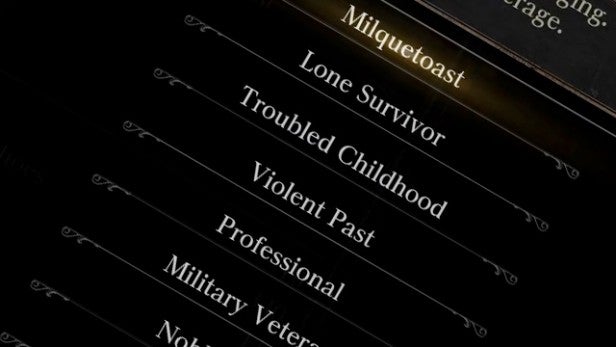
What do the stats mean?
As
ever with a From Software game, Bloodborne doesn't go out of its way to
explain anything in the game. Here's a quick look at what each actually
means:
Blood Echoes: This is Bloodborne's currency. It's important, but not when selecting a class. Don't factor this into a class choice.
VItality:
The biggest factor in deciding how many hit points your character has.
Along with your defence stat, this governs how much damage you can soak
up.
Endurance: This one affects, primarily, your stamina
bar – the green bar you'll see below your health bar. It takes a hit
whenever you attack, roll away to dodge or run. It's very important in
staying nimble, especially if you use a bigger weapon.
Strength: Obvious one, this. Strength is the primary stat that affects the damage done by standard melee weapons.
Bloodtinge: This
is initially the most confusing of all the stats. Bloodtinge affects
the power of your firearms. To start with they're pretty weak compared
to your main weapon, so if you want a 'mostly gun-firing' character, you
have a tough road ahead.
Arcane: Determining magic skill, Arcane isn't much use during the first stages of Bloodborne, but will come in handy later.
Related: Best FPS Games
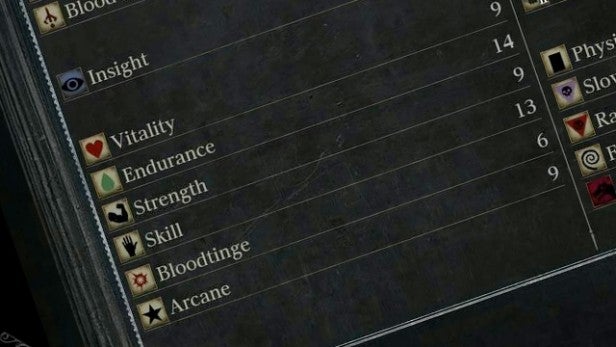
Starting area
At
the start of the game, you wake up in Yarnham. It's a city that has
made its way so far down the drain it's basically post-apocalyptic.
The
flavour of apocalypse for this scene is a strange disease that turns
people into nasty werewolf-like characters, plenty of whom you'll get to
meet further down the line. You enter Yarnham as the hunt is happening.
It's a city-wide purge Bloodborne doesn't even try to explain, but
means there are gangs of enemies to deal with right from the off.
But
first, we have to deal with a werewolf. As you stumble down from the
starting room, the clinic, you'll meet a near-death werewolf. On first
attempt you're meant to die. You're unarmed, and we've not yet managed
to kill the thing with karate chops alone.
On your death you're
taken to Hunter's Dream. This is Bloodborne's hub area. It's safe, it's
where you level-up and where you can transport to other areas of the
game.
On first visiting Hunter's Dream you'll pick up your
starter weapons, by interacting with hotspots up the stairs near to the
point where you wake up, post werewolf-mauling.
Related: Best PSN Games 2015
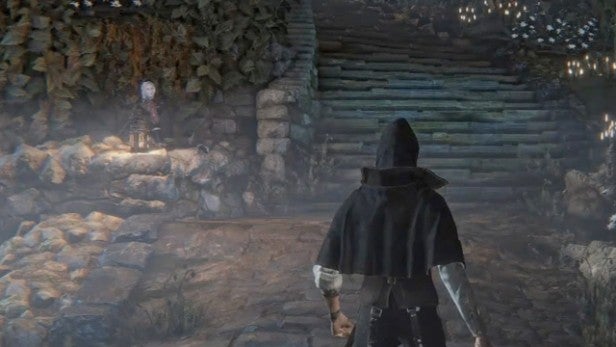
Starter weapons
You need to pick between three melee weapons and two ranged ones. On the melee side, there's a saw, an axe and a cane.
They
break down into a pretty typical spread of weapon types. The Axe is big
and powerful, the saw is faster and slightly less powerful while the
cane is very nimble but doesn't do a huge amount of damage.
Try
to match up the weapon to the class you picked. We favoured the axe for
its great charged attack, but the general consensus seems to be that the
saw is the most versatile.
The ranged weapons are even more
clearly separated. The blunderbuss is a short-range weapon that fires
pellets out at a fairly wide angle, and can be used to knock back a gang
of enemies running towards you. It doesn't inflict all that much
damage, though — none at anything but close-range.
The pistol
has a longer range, and inflicts more damage, but only hits one target.
It's not going to be all that useful when a whole gang of enemies is
running towards you. For most classes, the blunderbuss is more useful.
After
choosing your weapons and making your way back to Yarnham, make sure to
equip them before taking on the werewolf again. As usual Bloodborne
doesn't help you out here, but if you cant work it our for yourself you
might as well give up.
If you think you made the wrong choice,
don't worry. After you kill the first boss you're able to buy all these
weapons from the merchant in Hunter's Dream (along with some others).
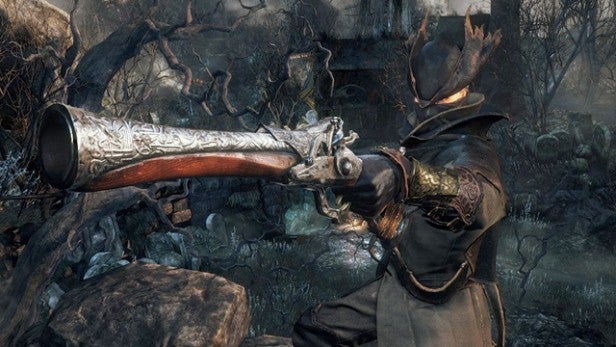
How weapons work in Bloodborne
Bloodborne
takes quite a different approach to combat to the other From Software
games. You cannot rely on a shield, and the game forces you into a more
aggressive combat style.
However, after you've taken damage, you
can actually regain much of the health by hitting back within a certain
amount of time. It's a neat mechanic that makes combat feel more
action-heavy than, for example, Dark Souls II. You still need to be
careful, though – it's not much good if you end up getting hit again
trying to regain some of your health.
Main weapons also have two
'modes'. They can be used as large weapons that do more damage, but are
slower and may rule out being able to use a firearm, or smaller
single-handed weapons that have slightly less damage, and generally less
range. You can flick between these two modes fairly rapidly by pressing
L1, but it's not so quick you can do so easily mid-combat.
Related: Best Games of 2015
How to level up
Blood
Echoes are used to buy items from merchants and to level up. Initially,
you can buy some items from the merchant in the bird bath (well that's
what it looks like) in the Hunter's Dream hub, while you level-up by
talking to the doll, also in Hunter's Dream.
However, for the
first chunk of the game the doll will be an inanimate object: it needs
to come to life before you can spend Blood Echoes on improving your
character. We're yet to work out the exact trigger that makes the doll
come to life, but we had explored most of Yarnham before it did. And
lost about 10,000 Blood Echoes in the process.
Rather than
simply stockpiling Blood Echoes while waiting for the doll to awake,
consider buying improved armour from the merchant in Hunter's Dream.
There's a full set of 'Yarnham' gear to be had that'll suck up 2500
Blood Echoes. There's no way to keep Blood Echoes safe directly so buy
this gear to avoid just losing that early currency.
Stockpile items to 'reserve' cash
So
you can't keep Blood Echoes safe, but you can keep an indirect store of
them by stockpiling items. In Hunter's Dream, one of the tables in the
house lets you store items. These can then be sold when you need an
extra cash injection to level up.
In other words, don't just
sell items as soon as you no longer need them. Store them instead and
sell them when you need the cash.
Check in on the messengers every now and then
Messengers
are the creepy little grey guys you see in floor hotspots, and they
also sell you stuff in Hunter's Dream. More of them appear as you defeat
bosses and progress through the game, unlocking more 'layers' of
equipment.
There are also other fountains in Hunter's Dream, one
at the side of the main house and one in the little hidden garden
behind it. These aren't unlocked too early in the game, but it's best to
check up on them every now and then in case a new messenger has
popped-up.
Combat tactics
The O button is you best
friend during combat. Whenever you meet a new enemy, instead of soiling
yourself and mashing the attack button, try to observe it. Each enemy
has a series of attack patterns. Learning them is how to really get
ahead in Bloodborne, much more than levelling up your character.
Avoid
at all costs getting surrounded by enemies. Even if you know attack
patterns, that won't come in too handy when a whole bunch of them are
being pelted at you at different intervals, at different angles.
If
you picked the blunderbuss as your starter weapon, use that to delay
their attacks as they approach, then use a swiping attack that will hit
more than one enemy. Killing enemies earns you Blood Echoes, although
there are also plenty of items that can be 'used' to earn you them too.
What are Lamps?
In
Dark Souls II, Bloodborne's predecessor in all but name, bonfires are
used as continue points. In Bloodborne, there are lamps instead. They
play much the same role – our assumption is that the slightly more
modern lamp was seen as fitting in better with the more modern aesthetic
of Bloodborne's gun-filled world.
When you use a lamp you can
teleport back to Hunter's Dream, where you can effectively 'cash in' any
Blood Echoes you've earned by killing enemies. However, doing so also
resets the enemies throughout the game. They all re-spawn.
Enemy respawn
Unlike
Dark Souls II, enemies don't stop respawning after a while either. In
Dark Souls II, this was a measure to stop players simply mining a single
area over and over again to level up, unbalancing the game. It seems
From Software has decided that the more active combat minimises the
issue of the player becoming overpowered: you're never immune to a good
mauling in Bloodborne.
Related: Best Racing Games 2015
Dying and Losing Blood Echoes
Died
again? Well, it happens a lot in Bloodborne. However, unless you die
somewhere particularly nasty, there's not necessarily that much of a tax
on death in the game.
When you die, you lose your Blood Echoes
and are transported to the nearest lamp. However, the Blood Echoes are
only truly gone if you die again without re-collecting them.
You
can find your lost Blood Echoes by tracking back to where you died.
They'll either be there as a glowing mass on the floor, looking a bit
like a steaming mass of dog mess, or an enemy will have nicked them. Any
enemy in possession of your Blood Echoes will glow, in the eyes. Kill
them and you'll regain your stash.
Killing the first boss – Cleric Beast
Getting
past the first couple of bosses is the first set of big hurdles you
need to get over. The Cleric Beast is the first you should encounter,
and it's found on a rampart of the upper area of Yarnham, behind a pair
of werewolves.
These werewolves are very tricky to kill, so we
recommend exploring until you find the shortcut that takes you ahead of
them. It sits in the dark house where you'll find the enemy in a
wheelchair – just go up the stairs and you're there. Alternatively, lure
the werewolves to this house. You can get in, but they're too big to
fit through the door, giving you the advantage.
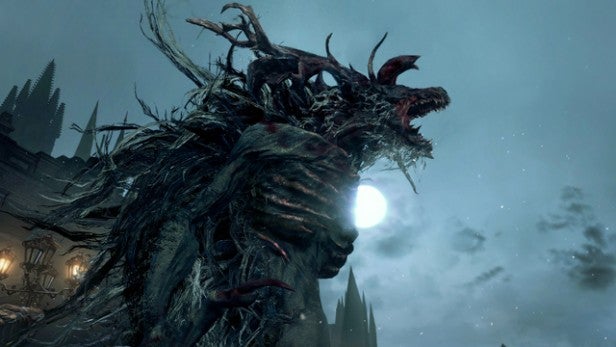
To
defeat the Cleric Beast our top recommendation is to take your time.
This boss' behaviour stays pretty consistent throughout the fight, and
its attacks aren't too hard to dodge a good 75 per cent of the time. So
just don't get greedy, just take it slow. With careful use of the dash
move, you can get behind the boss when it tries to attack you and give
it a heavy attack, before dodging out of the way to avoid getting stuck
by any of its follow-up hits.
You'll ideally want to level-up your character a little first, though, or it'll take an age.
Killing the second boss – Father Gascoigne
If
you take a few wrong turns you may find yourself up against Father
Gascoigne before you encounter the Cleric Beast. We think he's trickier
than that boss, so think about heading back if you find Gascoigne first.
He's a hunter like you, but has been infected by the
lycanthropy virus, as you find out during the fight. When his health is
reduced to around 15-20 per cent, he turns into a giant werewolf.
Even
before this, though, he's pretty tricky. We had the most luck when
luring Gascoigne up to the flat paved area up the stairs. Below this,
where you start, is filled with gravestones that can stop you from
avoiding his attacks successfully. Up at the top area, Gascoigne's
attacks are also easier to predict.
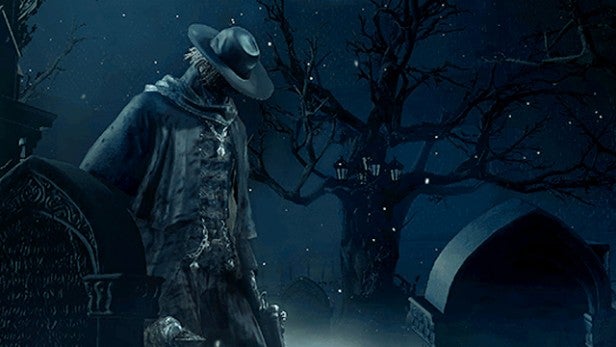
By
dodging out of the way of his slashes, you'll find enough of a window
to charge up a heavy attack that should knock a fair bit of health off
him. It may be worth upgrading your weapon if you find the battle very
hard. Once he transforms into the werewolf, the fight becomes even
trickier as those gaps are very small. You may want to keep some Molotov
Cocktails handy, as there's not enough time for super attacks in this
last stage.
What is insight?
Insight is left initially
as a mystery in Bloodborne. However, within Yarnham you'll pick up a
bell that uses Insight to let you summon other players to help you in
the game's trickier bits.
At certain points Bloodborne simply
gives you additional Insight, but you can also gain extra Insight by
using an item called Madman's Knowledge. These are, like most things,
just found around the game world.
How to upgrade weapons
As
well as levelling up your character, you can upgrade your weapons.
Using one of the tables in the house of Hunter's Dream and items called
Blood Stone Shards, you can significantly increase the damage they
inflict.
In the early part of the game, these are most commonly
dropped by the half-werewolf enemies. You can upgrade your weapons three
times before the upgrade cycle will move onto a new catalyst. This is
there to limit how much you can super-charge your weapons in the first
area.
Related: Battlefield Hardline review
Don't forget you can run and slide down ladders
Your
character in Bloodborne is pretty nimble. More so than you may realise
to start with. Don't forget that using the O button you can run and
slide quickly down ladders.
Some enemies will follow you up and down ladders, so use the slide move to get a lead on them.
Have any other tips and tricks of your own? Let us know in the comments below.
Can Friends Pick Up Knowledge in Bloodborne
Source: https://www.trustedreviews.com/opinion/bloodborne-tips-and-tricks-2924115
